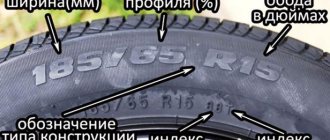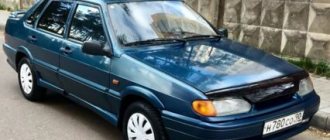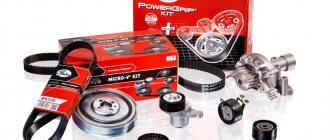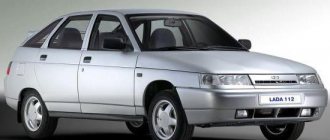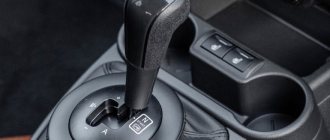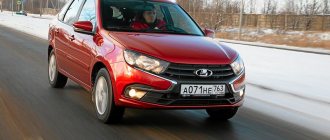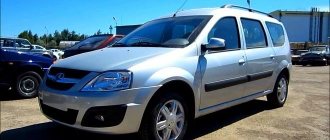Rubber provides traction between the wheels and the road and transfers engine power to the asphalt. It is important to choose the right kit for your car so that the operation of the car is as efficient as possible. Each set has such a parameter as the seasonality of the tires. Next, information will be presented about all-season tires, the features of their markings and the properties of this rubber.
In order to identify all-season tires by marking, such tires have an additional designation in the form of the letters M+S. The abbreviation Mud+Snow means that the kit provides reliable traction in difficult weather conditions. In addition, all-season tires are designated by the symbols 4S, AS or AW (4 Season, All Season or All Weather).
However, it should be understood that, in essence, all-season tires lose to winter tires at low temperatures and lag behind summer tires at high air temperatures. In fact, these tires are considered more of an off-season tire.
What is an all-season tire?
Various sets of seasonal tires are offered for the car, which differ in their characteristics and composition.
Winter tires are made of soft types of rubber, which will prevent the tire from becoming tanned. In addition, such products have a developed tread pattern and a high profile, which allows them to cling to slush and effectively drain water. The difference between summer tires is hard rubber. This tire tolerates high loads well and does not melt while driving, confidently clinging to the surface. The profile height is small, and the contact patch with the road is the most extensive. However, in low-temperature conditions it becomes dull and does not provide proper grip, which results in a long braking distance.
Finding out whether you have summer or winter tires is quite easy. Sets without any additional marks are considered summer. All-season tires are designated by the letters 4S, AS, M+S, and the Velcro or studded tires are marked with snowflake designs.
Comparison
The main difference between winter and summer tires is the quality of the rubber alloy. Winter tires have better grip on the road surface, and also provide good vehicle handling and shorten its braking distance. Winter tires have a very interesting property: they are able to warm up while driving at very low temperatures, while they become softer and more elastic. It is the elasticity that provides excellent road grip.
Summer tires have the opposite qualities: even when driving fast and at high air temperatures, they cool down, becoming very hard and shaped. Thanks to this quality, summer tires are ideal for fast driving, but only on good roads. The difference between summer and winter tires is their expiration date. For example, summer tires are much more susceptible to wear than winter tires. Therefore, it needs to be changed approximately three times more often.
One of the most important qualities of rubber is the maximum speed at which you can ride on it. In this regard, winter tires are in many respects inferior to summer tires. Even with very high-quality road grip, it is not recommended to drive faster than 140 km/h in winter. When purchasing winter tires, you should be extremely careful, because driving safety depends on their quality. Trust only proven brands that are constantly working to improve their products by conducting numerous tests.
Parameters and characteristics of rubber
Each set has a concept of tire seasonality. Despite the fact that tires of a certain composition are labeled as all-season tires, such a set is demi-season tires. These all-season tires have a softer rubber compound. In the summer, the all-season tire will overheat and “float,” which will lead to premature wear.
In the case of ultra-low temperatures, tires will lose to their winter counterparts. Such kits work most effectively at near-zero levels, providing proper grip on cold asphalt, slush or rain. In such conditions, rubber can be used, but you should not ride on it all year round; you should wear specialized shoes for the winter or summer season.
What else should you pay attention to when choosing all-season tires?
Usually, all-season tires are determined by other criteria, and not just by markings, because a novice driver cannot fully remember all the necessary parameters, although visually selecting the optimal tire option is quite possible.
Unlike summer tires, all-season tires can be used at low sub-zero temperatures, but if there is severe frost, then all-season tires will be powerless against glass-smooth asphalt. Such tires can be identified both by weight and by touch. To do this, you just need to compare two samples in your hands. Summer tires will be much lighter than those that allow you to drive your car all year round.
At the same time, the composition of the all-season rubber compound will be much softer. To do this, just press the surface of the tire with your finger and wait a little. If the rubber compound, after such pressing, as well as after pressing with the palm, was pressed in and then straightened back out, but after some time, then it is worth thinking about the fact that in front of the person there is a truly real all-season tire.
Don't forget that all-season tires can be used at any time of the year. Although, on the other hand, experts are skeptical about this option of shoes for the car, since it does not carry any special characteristics.
Choosing a pair of good tires for summer and winter, which you can then change for each season, is, without a doubt, a more profitable and convenient option. After all, the car owner will feel confident on any type of road surface. But there is no extra money for storage, purchase and changing shoes, so you will have to use all-season tires.
We must not forget that at very high and very low temperatures, such rubber loses the properties of both summer and winter options. the length of the braking distance is disrupted - it is greatly reduced, irreversible processes occur with a pattern that in a matter of months turns into a completely bare wheel.
It is also important to remember that such rubber is manufactured in countries where winter usually passes as quickly as possible. During the rest of the year, you can often see slush, moisture, or even some ice on the roads. If all this is true, then all-season vehicles will last about 5 years.
Pros and cons of operation
Each kit has its pros and cons.
All-season tires are no exception. Advantages:
- allow you to save money by purchasing only one set of wheels;
- feel good at zero temperatures, on wet or snowy asphalt.
Flaws:
- significantly lose to profile tires, subject to seasonality. At high temperatures the tire “floats”, and when the thermometer table is lowered, it becomes tanned. In winter the car must be on winter tires, and in summer - on summer tires.
The difference between summer tires and winter tires
Many readers of my blog often ask me what is the difference between summer tires and winter tires, except for studs and tread.
And why can’t you drive on winter tires in the summer and summer tires in the winter? I decided to reveal all these questions in the next article. For those interested, read on... At first glance, they can be distinguished purely visually. The winter version has a coarser and deeper tread, as well as a completely different pattern, which, as a rule, is not similar to the pattern on the summer model, it also has studs for good grip on winter roads, for example with ice (by the way, there are now a lot of types of them, read this article). But the difference lies not only in the design and the presence of spikes, here guys everything is much more complicated.
Summer tires are made from a specific rubber compound that can withstand very high temperatures above zero. Asphalt is quite hot in summer, and the wheels must withstand these temperatures during acceleration and braking. It should be noted that it is much tougher than winter. But as the temperature drops below zero, summer tires become completely inelastic, and a car on such wheels can easily skid. A simple example: place a regular eraser in the snow in the cold and leave it for two to three hours. Then take an eraser and try to bend it. The eraser will lose its elasticity and break easily. The same thing happens with the summer version in the cold, it becomes dull and wears out very quickly, and it’s simply not possible to drive on such tires!
Remember! Summer tire - must be used until the temperature is below zero, that is, minus one, we change it immediately, even if there is no snow.
The winter version also has a certain composition. Only the focus here is completely different. Winter does not please us with warm days; the thermometer is almost always in the sub-zero zone, sometimes even exceeding -35. And the task is to remain elastic in such frosts and provide maximum grip on the road. The difference between winter tires and their opponents is their softness, that is, they are much softer than summer tires. And the high tread and spikes or Velcro already fight snow and ice. Therefore, it looks much more massive, with a high tread. You just need something to cling and dig up the snow. However, it is absolutely not adapted to above-zero temperatures, and especially to rain. A car with spikes in puddles is like a “cow on ice”; it is difficult to control. And hot asphalt quickly wears out soft winter tires. Try to heat the same eraser and run it across the asphalt; it will leave a trail of small pieces of rubber behind it; when heated, it collapses very quickly. About the same thing happens with a tire; its soft base literally melts in the heat, on hot asphalt.
Remember! This type should be used up to the plus mark. If the snow has melted and it’s already plus one at night, then it’s better to change it.
Sometimes it may seem, especially when driving on asphalt, that winter tires are much harder than summer tires, but this is not the case. The hum that occurs when the car is moving is caused by the studs and high tread, not by the harshness.
Now guys, this is a very useful comparative video, although it’s in English, but you can catch the main points, let’s take a look.
That's all, I tried to explain the differences as clearly as possible, I hope you liked it
(
13 votes, average: 4.23 out of 5)
Tire size
The tire size is also indicated on the sidewall of the tire. There is a European type of marking. For example, readings 205*35*R17 make it clear that the tire width is 205 mm, the profile height is 45, and the inner diameter is 17 inches. The letter r means that we are looking at shoes with radial cord weaving.
The American method is similar to the European one, only in front of the numbers there are additional letters that signal the “orientation” of the rubber (P – Passanger, LT – Light Track). There is another way to indicate the standard size, where the values are given in inches. For example, if there is a number 29*11*R18 on the side, its decoding will mean the following:
- 29 – outer diameter in inches;
- 11 – tire width;
- 18 – internal diameter.
Winter tire markings and summer tire markings
To recognize the season, the easiest way is to find the winter markings for m + s (mud and snow) and 3PMSF tires. It should be noted that not every m+s tire is winter. This abbreviation is only a manufacturer's declaration regarding the proposed performance. You may find this designation among others on tires for the US market, where the requirements and standards are slightly different from European ones. M+S is also a common designation for all-season tires. The 3PMSF mark, depicted as a snowflake against a background of three peaks, is a clear indication of the purpose of the model. A tire with this marking was created taking into account the winter conditions that we can encounter in Europe. It will work both during the capricious winter and during a trip to the mountains (although during such a trip it is always worth having chains with you).
The symbol of three peaks with a snowflake is typical for winter tires. All-season tire markings may vary depending on the manufacturer.
The designation of winter and multi-season tires is often reflected in the names of individual models. Manufacturers suggest tires by placing names such as "Winter", "Alpin", "MS" or "4Season" and "All Weather".
All-season models are designed to provide safe driving regardless of conditions, without the need to replace them with seasonal tires. The universal solution is usually chosen by drivers who prefer a relaxed driving style and travel mainly around the city and short distances.
Speed index
Another required parameter is the speed index. This is a letter designation that indicates that the car can move at a given speed for several hours. The closer the letter is to the end of the Latin alphabet, the higher this indicator. Now the most common are kits with the indexes S, T, U, HV or W, allowing speeds of 180-190-200-210-240 or 260 km/h, respectively.
Characteristics
Many drivers do not know how to choose the right summer tires and not make a mistake. The main thing is not to ignore some characteristics, so as not to accidentally purchase a low-quality product.
In addition to seasonality, tires are divided by size, type of construction, weight and other properties. When choosing, you should also take into account your own driving style, the recommendations of the car manufacturer and the cost of tires. Let's look at each characteristic separately.
Standard size
The size is a parameter that is indicated on the side of the tire. It consists of letters and numbers. When coming to a retail auto store, the driver must first tell the seller the standard size.
The standard size is the ratio of the width, height, and outer diameter of the tire. For example, the marking 160/75 R16 is deciphered as follows:
160 - tire width in millimeters. A narrow tire looks nicer. However, wide tires provide better traction and faster acceleration.
75 - sidewall height relative to width. Shown as a percentage.
16 is not the tire radius, as many people think, but the bore diameter. The letter R indicates that the tire is radial. The value is indicated in inches.
Wide tires are heavier, which means they worsen the car’s handling on asphalt with potholes and holes. On wet roads they create a hydroplaning effect.
Construction type
There are several types of tire construction. They are usually divided into tube and tubeless. The latter are used for passenger cars.
If the tires are marked Light Truck or Cargo, then these products are reinforced. These tires are used for minivans or trucks. High-quality tires are also considered to be those made using RunFlat technology. It has a reinforced frame and a wide side ring. The sidewalls continue to support weight, even if the tire is punctured.
Profile height
The profile height is an indicator that is indicated in the markings on the tire. The index in % is in second place after the tire width in millimeters. The tires themselves are further divided into low-, high- and full-profile. Each type has its own characteristics.
For example, low-profile ones provide the car owner with good handling. If you drive on such tires on bad roads, this will negatively affect the suspension. For this reason, low-profile tires are installed on cars with strong suspension.
High- and full-profile tires are excellent for off-road use. It helps to “dampen” potholes and cracks on the road and protects the suspension from damage.
Tread pattern
Tread patterns on tires for passenger cars are divided into symmetrical and asymmetrical. Each of these types can be non-directional and directional.
Symmetrical non-directional ones are suitable for those who like a quiet ride. The pattern creates a smooth running of the machine and low noise level. Directional tires have a symmetrical pattern with grooves that radiate from the center to the edges. Their main advantage is the ability to reduce the effect of aquaplaning. The disadvantages include the inability to take such tires as a spare tire.
Asymmetrical directional tires are not very common, since the pattern has limitations in directionality. This is inconvenient for most drivers. Non-directional asymmetric tires, on the contrary, are considered universal. They can be swapped. In addition, they have high controllability. They can be used in both dry and wet weather.
Load Index
The load index refers to the maximum weight that one wheel can support. The heavier the car, the greater the load on the tires. When choosing tires, the owner should focus on this indicator. It is advisable to determine in advance whether heavy loads will be transported on this machine. If yes, then you should pay attention to tires with a higher load index.
Speed index
Speed index is an indicator denoted in Latin letters. It indicates the maximum speed the driver can drive on a given tire. For lovers of leisurely driving, models with indexes P and Q are suitable. For those who “drive” at high speeds, tires with indexes H and V are needed.
Disc diameter
Tires are either radial or bias-ply by design. The latter variety is practically never found on the market. Most car enthusiasts install radial tires. Their diameter is included in the size marking and is designated by the letter R.
Tire noise
Noise is an indicator that affects comfortable driving. The level of noise a tire makes depends on the tread pattern. You won't be able to determine the noise yourself. You can trust the opinion of salespeople in the store, ask friends for information, or read advice on the Internet.
Load index
Along with the speed category, tire manufacturers put down two more numbers - the maximum load index. This parameter means that the tire is capable of traveling under the specified weight on one wheel, subject to maximum pressure. The indicator is indicated in kilopascals closer to the inner radius.
The higher the indicator, the greater the load that the wheel can carry. The minimum value in the industry is 1 - 46.2 kg per wheel, and the maximum figure is 279 - 13.6 tons per cylinder.
All-season and winter tires. Comparison of main parameters
General characteristics of tires for all seasons and winter:
- Used at sub-zero temperatures. The rubber composition is balanced in such a way that it does not become hard in cold weather and remains elastic.
- They are distinguished by increased cross-country ability. The tread pattern in the form of individual blocks provides good grip on slippery roads.
- The design contains lamellas. They are thin cuts on the sides of the tire that resist slipping by clinging to snow and ice with their edges.
What is the difference between winter and all-season?
- Temperature range of use. If winter tires can be used at any negative temperature without restrictions, then all-season tires become too hard for safe movement even at -7 °C.
- Handling on slippery roads. The deep tread of winter tires (from 9 to 17 mm) allows you to easily maneuver during icy conditions. All-weather tires have lower tread. It is about 8-9 mm, so driving a car on such wheels is much more difficult.
- Braking distances. It has been experimentally proven that the braking distance on all-season tires is longer than on winter tires (by about 30%). This is a significant difference between all-season tires and Velcro and studded tires.
- Tread pattern. Winter tires are easily distinguished by their larger blocks and pronounced pattern. The sections on the running surface of “All season” tires are smaller. They are distinguished by a large number of drainage grooves, which improves its performance on wet asphalt.
Conclusion: tires intended for any season are inferior to winter tires in all respects. The difference is less noticeable at temperatures close to 0°C. On wet road surfaces, an all-season vehicle can show better handling due to high-quality water drainage.
Marking
Sometimes the marking of all-season tires can be supplemented with various icons. Among the additional symbols you can find the inscription “Retread”. The fact is that some kits need to be repaired and the compound is re-fused onto them and the tread is cut. Refurbished products carry this designation. Driving on such tires does not pose any danger, but the tire purchased by the driver will wear out a little earlier. Fortunately, the price is cheaper.
Some car tires and wheels do not fit together, having fundamental differences in design. So, if you are going to change the tires of your car yourself, it is worth remembering that the tube sets must be installed on the corresponding wheels with the designations LK, GK or RK. The symbols LB, GB or RB indicate combination with tubeless type kits (TubeLess).
Tire installation rules regulate the presence of color marks. If there is a yellow triangle icon on the sidewall, then this is the lightest part of the rubber. All you need to do is align it with the mark on the disc. The red dot indicates the hardest point and should also be aligned with the L mark on alloy wheels.
Rubber composition is more important than tread
The tread pattern itself is extremely easy to copy - even high-quality R18 tires https://tyreg.by/catalog/tires/r18/, from well-known manufacturers, and their cheap Asian fakes often look almost the same. On the road, however, they behave very differently. This is the best proof of the importance of the materials from which tires are made. The composition of the mixture is a closely guarded secret of well-known manufacturers.
Tires intended for use in summer conditions are made of harder rubber, which must be resistant to high temperatures. However, this material is completely unsuitable for winter tires, since at low temperatures it becomes harder, which negatively affects grip.
Winter tires are made from compounds that remain flexible even in very cold temperatures. However, their disadvantages become apparent when it gets too warm. In hot weather, such rubber becomes too soft, causing the tires to wear out at an alarming rate, and the car becomes uncontrollable on the road.
Selection for SUV or crossover
We told you how to distinguish winter tires from summer tires - by the snowflake icon. However, to choose shoes for a non-trivial car, this knowledge may not be enough. When purchasing wheels for a crossover, you should imagine where the car will spend most of its time. If in the city, then standard tires with the designation AW (All Weather or Aqua - improved drainage and increased resistance to aquaplaning) are a good choice.
If the car goes beyond the definition of an SUV and you are planning trips into nature, then it is better to give preference to sets with a developed tire tread, improved lugs and increased cross-country ability. Such kits are designated by the letters AT - All Terrain.
For real off-road vehicles, special tires like Bridgestone Dueler are used, which have proven themselves in combat conditions and have high load resistance and excellent grip. This set is more expensive than the standard one, but its price is justified by its excellent qualities.
Tip 5. Load and speed
The load and speed indices must exceed the capabilities of your vehicle. But an excessive margin in these parameters will make the tire hard and heavy, which will have a bad effect on comfort and fuel consumption.
The lighter the tire, the better. Energy Saver technologies are found in some high-end tires and actually provide fuel savings. And when choosing regular tires, give preference to lighter ones; they will also reduce fuel consumption.
Load and speed index. Too much reserve for these parameters is expensive and unnecessary.
Load and speed index. Too much reserve for these parameters is expensive and unnecessary.
Studless tires - features of choice
Winter tires of this type are divided into two types. Manufacturers of such products supply the world market with:
European tires;
Scandinavian tires.
The choice between these two types is due to the fact that each option will be optimal in its own weather conditions. Let's take a closer look at each type of rubber.
European tires. Purpose.
Ensuring the most effective adhesion of the tire to the road surface in bad weather conditions (rain, sleet).
Description.
At its core, rubber is somewhat similar to regular rain tires. It has a diagonal tread pattern with a large number of drainage channels, which, when connected, form a developed network. You can also distinguish European-type rubber by the presence of thin slots (lamellas) and large lugs located along the edge of the tread.
Moreover, the ability of rubber to provide greater grip directly depends on the length of the slots. The higher this indicator, the longer each tread edge, with the help of which the tire literally “clings” to the road surface when the car is moving. In this case, the same porridge gets into the slots, and the tire then comes into direct contact with the road surface.
Scandinavian tires. Purpose.
Ensuring optimal grip on icy conditions
road and road surface with snow crust.
Description.
It has a less developed network of patterns, in which not slots predominate, but special figures that have a rectangular or diamond shape and alternate in a checkerboard pattern. These figures are not located too often, thanks to which the tread easily breaks through the top layer of ice or snow crust while the car is moving, and then cleans itself. Thanks to this design, the car is ideal for traveling over rough terrain.
